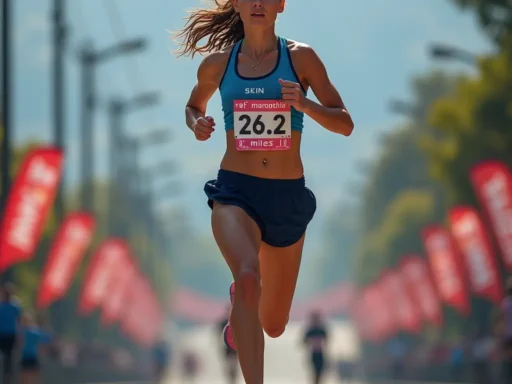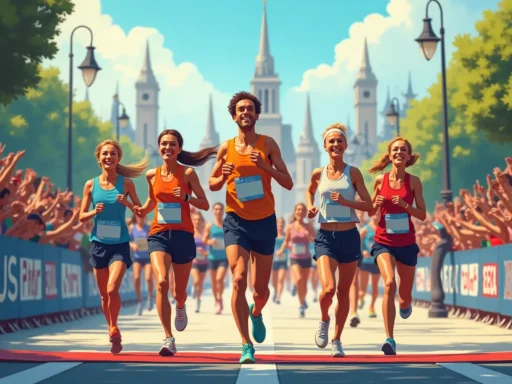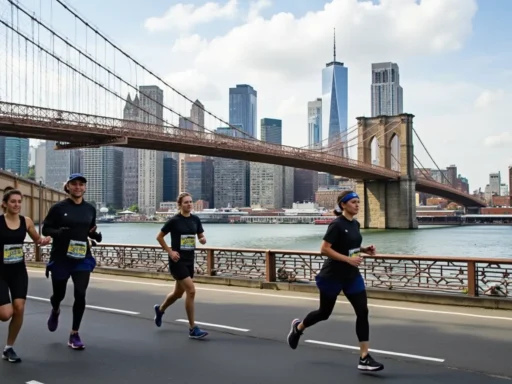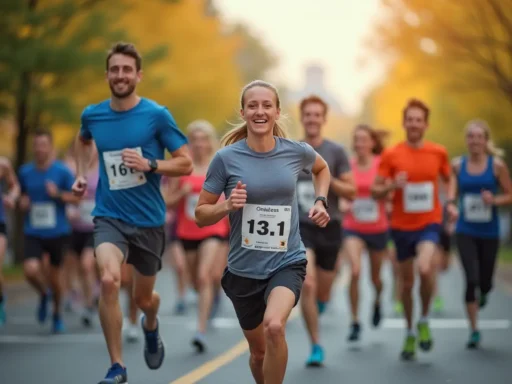Are you ready to take on a challenge of a lifetime? Knowing the marathon distance is key. A marathon measures 42.195 kilometers, which is equivalent to 26.2 miles. This knowledge is vital for creating a training plan to conquer this incredible feat.
Whether you’re an experienced runner or just starting, finishing a marathon is a big deal. This guide will cover the basics of marathon running. You’ll learn about the distance, training, and preparation. You’ll also discover the history of the marathon, how to pace yourself, and what to expect on the course.

Starting your marathon journey means understanding it’s more than just a number. It’s a test of endurance, mental strength, and physical power. With the right training and prep, you’ll be ready to face the challenge and achieve your goals. Let’s dive into the world of marathon running and what it takes to succeed.
Table of Contents
How Many km is a Marathon: The Official Distance Explained
The official marathon distance is 42.195 kilometers, or 26.219 miles. To grasp how many km is a marathon, knowing its history is key. The IAAF set this distance in 1921.
The marathon’s distance was first around 40 kilometers in the 1896 Olympics. But, the 1908 London Olympics made it 26.2 miles (42.195 kilometers). This change was for the royal family’s viewing pleasure.
Converting Marathon Miles to Kilometers
To convert marathon miles to kilometers, use this simple rule: 1 mile equals 1.60934 kilometers. So, 26.2 miles is the same as 42.195 kilometers.
Why Marathons Are This Specific Distance
The marathon’s distance, 42.195 kilometers, has stayed the same since 1921. It’s a famous challenge for runners everywhere. Over 1,100 marathons are held in the U.S. each year.
Standard Marathon Course Measurement Methods
Measuring the marathon course accurately is vital. It ensures runners run the full 42.195 kilometers.
| Marathon Distance | Kilometers | Miles |
|---|---|---|
| Official Marathon Distance | 42.195 | 26.219 |
| Half-Marathon Distance | 21.0975 | 13.109 |
Knowing the marathon distance in km is crucial for runners. It helps them prepare and train. Whether you’re experienced or new, understanding the marathon distance boosts your confidence.
The History Behind the Marathon Distance
The marathon history is a captivating tale from ancient Greece. It starts with Pheidippides, a Greek messenger. He ran from Marathon to Athens to share news of a victory against the Persians. This legendary run inspired the modern marathon event.
The first official marathon was at the 1896 Modern Olympics in Athens, Greece.
Here are some key milestones in the evolution of the marathon distance:
- The first modern Olympic Marathon was held over a distance of 40 kilometers.
- The first Boston Marathon took place in 1897, making it the oldest annual marathon.
- The 1908 London Marathon distance was initially set at 26 miles but increased by 385 yards due to a royal request.
The marathon distance has seen many changes over the years. Yet, its rich marathon history is a big part of its charm. From ancient Greece to today, the marathon inspires and challenges runners worldwide.
| Year | Event | Distance |
|---|---|---|
| 1896 | First Modern Olympic Marathon | 40 km |
| 1897 | First Boston Marathon | 24.5 miles |
| 1908 | London Marathon | 26 miles 385 yards |
Breaking Down the Marathon Course
Getting ready for a marathon means knowing the course. It’s split into parts, each with its own hurdles. By tackling these sections one by one, you can plan your race strategy.
The marathon is divided into four main parts: warming up, finding your pace, facing the challenge, and the final push. Knowing these segments and how to tackle them is key to finishing strong.
Start to 10K: The Warm-Up Phase
This first part is for getting ready. It’s important to pace yourself and save energy for later.
10K to Half-Marathon: Finding Your Rhythm
Here, you start to find your pace. It’s vital to stay focused and keep a steady pace to save energy for the end.
20K to 30K: The Challenge Zone
This part is the toughest. You’ll need to find the strength to get through it.
The Final 12.195K: The Mental Game
The last part is all about mental strength. You’ll need every bit of energy and willpower to finish.
Knowing the marathon’s parts and planning for each helps you succeed. It sets you up to reach your marathon goal.
| Segment | Distance | Challenges |
|---|---|---|
| Warm-Up Phase | 0-10K | Pacing, energy conservation |
| Finding Your Rhythm | 10K-Half-Marathon | Staying focused, maintaining pace |
| Challenge Zone | 20K-30K | Mental and physical toughness |
| The Final Push | 30K-Finish | Mental endurance, willpower |
Understanding Marathon Pace and Timing
When you’re getting ready for a marathon, knowing about marathon pace and marathon timing is key. A good pacing plan can really help you reach your goals. First, figure out your target finish time and then work back to find a realistic marathon pace.
It’s a good idea to keep a steady pace during the race. For instance, aiming for a sub-4 hour marathon means you should run about 5:41 minutes per kilometer. Use pacing charts or a GPS watch to keep track of your pace.
Here are some average pace needs for different finish times:
- Sub-4 hour marathon: 5:41 minutes per kilometer
- 4-5 hour marathon: 6-7 minutes per kilometer
- 5-6 hour marathon: 7-8 minutes per kilometer

Also, check out this table to plan your marathon pace and marathon timing:
| Pace (min/km) | Marathon Finish Time |
|---|---|
| 5:00 | 3:30:58 |
| 6:00 | 4:22:11 |
| 7:00 | 5:14:38 |
Understanding your marathon pace and marathon timing lets you create a plan for success. Stay consistent, listen to your body, and adjust your pace if needed. This way, you’ll have a great and successful marathon experience.
Essential Marathon Training Principles
For marathon training, a solid plan is key. It should cover base building, speed work, and long runs. A good plan boosts endurance, speed, and prepares your body for the marathon.
Beginners might do long runs of 25 kilometers. These runs include faster pace segments. This helps build endurance.
Marathon training focuses on gradually increasing mileage and intensity. This is done through base building, speed work, and long runs. These elements improve performance and lower injury risk. Experienced runners might do 2 x 10 kilometers at marathon pace. This boosts endurance and speed.
Here are key parts of a marathon training plan:
- Base building phase: Focuses on endurance and mileage increase.
- Speed work: Improves speed and efficiency.
- Long runs: Build endurance and mental toughness.
By following these principles and adding them to your plan, you’re on your way to success. You’ll reach your marathon goals.
Nutrition Strategies for Marathon Success
When you’re getting ready for a marathon, marathon nutrition is key. The right fueling for marathons can boost your endurance and results. The American College of Sports Medicine (ACSM) suggests eating 30-50% of your daily calories as complex carbs. This is especially important on heavy training days.
A good nutrition plan balances carbs, proteins, and fats. Endurance athletes need 4-6g/lb of carbs, 0.8-1.0g/lb of protein, and 0.4-0.6g/lb of healthy fats. It’s also important to test fueling for marathons during long runs to find what works best for you.
Here are some key nutrition tips for marathon runners:
- Consume 1.0–1.2g/kg/hour of carbohydrates during the first 4 hours post-exercise
- Aim for a 2:1 carbohydrate to protein ratio for recovery (women) or 4:1 ratio (men)
- Drink 5 to 12 ounces of fluids every 15 to 20 minutes during exercise
- Replete fluids slowly within 2 hours post-exercise, up to 150% of the weight lost
By focusing on proper marathon nutrition and fueling for marathons, you can improve your performance. Stay hydrated, listen to your body, and adjust your nutrition plan as needed.
| Nutrient | Recommended Daily Intake |
|---|---|
| Carbohydrates | 4-6g/lb |
| Protein | 0.8-1.0g/lb |
| Healthy Fats | 0.4-0.6g/lb |

Common Marathon Distance Variations
Many know the standard marathon distance is 26.2 miles or 42.2 kilometers. But, there are many other distances for different runners. For example, the half marathon distance is half of the full marathon, at 13.1 miles or 21.1 kilometers.
For those who are more experienced, ultra marathon distances are a bigger challenge. They go beyond the standard marathon, from 50 kilometers to over 100 miles. This requires a lot of physical fitness and endurance. Whether you’re starting with a half marathon distance or aiming for ultra marathon distances, there’s a marathon for you.
Some popular marathon variations include:
- 10km (6.2 miles)
- Half Marathon – 21.1km (13.1 miles)
- Marathon – 42.2km (26.2 miles)
- Ultra-Marathon – greater than 42.2km
These variations offer different challenges and chances to reach your goals.
Marathon Course Elevation Considerations
When getting ready for a marathon, think about the marathon course elevation. Hills and inclines can affect your performance. Adding hill training to your plan can boost your strength and endurance. This lets you face tough courses with confidence.
A good training plan should mix flat and hilly routes. This mimics the marathon’s demands. You might include:
- Short, intense hill repeats to build explosive power
- Longer, more gradual inclines to improve endurance
- Downhill running to practice control and technique
By doing hill training, you’ll be ready for the marathon course elevation. Whether it’s a gentle slope or a steep incline, you’ll be prepared. Always stay focused, listen to your body, and tweak your plan as needed. This will help you have a successful and enjoyable marathon.
| Marathon Course Feature | Description |
|---|---|
| Heartbreak Hill | A 3-kilometer hill with a 1,400-meter ascent, located at 32.5 kilometers into the course |
| Hill 1 | A 969-meter hill with a 22.9-meter ascent, located at 25.6 kilometers into the course |
Weather Impact on Marathon Performance
When you’re getting ready for a marathon, think about how the weather will affect you. Weather can really change how fast you run and what your experience is like. Studies show that temperature, humidity, and wind all play a part in your performance.
A study looked at data from 1258 races and found that air temperature is very important, with a score of 40%. The best temperature for running is between 10°C and 17.5°C. The wet bulb globe temperature (WBGT) also matters, with the best range being 7.5°C to 15°C.
Temperature Effects
Temperature can really impact your marathon time. Every degree off the best temperature can slow you down by 0.3% to 0.4%. This can mean a lot of time lost, especially in long races. For example, going from a WBGT of 17°C to 25°C can slow you down by 2.7%, adding about 3 minutes and 16 seconds to your time.
Humidity Considerations
Humidity is also key to consider. While it’s not as strongly linked to performance, high humidity can still affect you. A study found that humidity has a small but noticeable impact on speed, especially for the fastest runners.
Wind Factor Analysis
Wind can also impact your marathon, especially in terms of energy use and pace. The exact effect of wind is still being studied, but it’s important to be ready for different wind conditions on race day. Knowing how weather affects you can help you prepare better and run your best.
Recovery Techniques for Marathon Runners
After running a marathon, it’s key to focus on marathon recovery. This helps your body heal and get stronger. A good post-marathon recovery plan can greatly improve your performance and lower injury risks. Rest is crucial, letting your muscles fix and grow back.
Techniques like ice baths, wearing compression clothes, and planning your diet also help. These methods support your body’s healing.
A good post-marathon recovery plan mixes physical and nutritional strategies. For instance, walking for 10 to 15 minutes after a race can prevent sickness and aid in marathon recovery. Right after the race, eat a snack with 200 to 300 calories from carbs and protein within 30 to 60 minutes.
A suggested four-week post-marathon recovery plan includes low-impact exercises, short easy runs, and slowly increasing run distance and intensity.
- Engage in low-impact cross-training activities such as walking, cycling, or swimming
- Introduce short, easy runs, ideally between 30 to 60 minutes, if your body feels ready
- Gradually increase distance and intensity of runs if comfortable
Remember, marathon recovery is a vital part of your training. By resting, eating right, and moving gently, you can heal and get ready for your next marathon.
Technology and Marathon Distance Tracking
When you’re training for a marathon, you need marathon technology to track your progress. A GPS watch is key for accurate distance and pace tracking. But, research shows GPS watches might overestimate distances.
A study in the International Journal of Geographical Information Science found big errors. This means you might not get the real distance.
Choosing the right GPS watch is crucial. Brands like Garmin and Apple offer accurate ones. Also, marathon apps give insights into your training. They track pace, heart rate, and distance.
These tools help you train better and perform better in the marathon.
Here are some important features to look for in a GPS watch:
- High-accuracy GPS tracking
- Heart rate monitoring
- Customizable data screens
- Long battery life
Investing in a good GPS watch and using marathon technology can boost your training. It helps you reach your marathon goals.
Famous Marathon Courses Around the World
Are you getting ready for your next marathon? Think about running on some of the world’s most famous marathon courses. With over 800 marathons held every year, you have many choices. The World Marathon Majors, with six top marathons, draw thousands of runners annually.
The Boston Marathon, New York City Marathon, and London Marathon are well-known. They offer unique challenges and sights. For example, Boston’s Heartbreak Hill is infamous, while London’s route along the Thames is scenic.
Here are a few famous marathon courses:
- Tokyo Marathon: Known for its fast and flat course, with a men’s course record of 2:02:40.
- Chicago Marathon: Famous for its windy conditions, with a women’s course record of 2:14:04.
- Berlin Marathon: A favorite among elite runners, with a men’s course record of 2:01:09.
Running these famous marathons is an unforgettable experience. Thousands of spectators cheer you on. Whether you’re experienced or just starting, trying different courses can help you reach your running goals.
| Marathon | Course Record (Men) | Course Record (Women) |
|---|---|---|
| Tokyo Marathon | 2:02:40 | 2:16:02 |
| Chicago Marathon | 2:03:45 | 2:14:04 |
| Berlin Marathon | 2:01:09 | 2:15:37 |
Mental Strategies for Marathon Success
When you’re getting ready for a marathon, it’s key to work on marathon mental preparation. This helps you deal with the race’s physical and emotional challenges. Good mental strategies can greatly improve your performance and race experience.
Studies show that using mental strategies like visualization can boost performance by about 20%. Runners who use positive self-talk also feel less tired and more confident. They see a 30% increase in confidence. Adding these methods to your training can help you prepare better mentally and gain an edge.
Here are some important mental strategies to think about:
- Visualization: Imagine yourself crossing the finish line and overcoming race challenges
- Positive self-talk: Use encouraging thoughts to boost confidence and resilience
- Mindfulness: Stay present and focused during the race with mindfulness techniques
By focusing on marathon mental preparation and using effective mental strategies, you can reach your best performance. Stay focused, motivated, and committed to your training. This will help you have a successful marathon experience.
Your Marathon Journey Starts Here: Taking the First Step
Are you ready to start your marathon journey? It doesn’t matter if you’re a seasoned runner or a beginner. The path ahead might look tough, but with the right mindset and prep, you can do it. As a marathon beginner, set achievable goals and pick a training plan that fits your fitness level.
Building a solid marathon running base is key. Start by slowly increasing your distance, add speed workouts, and remember to rest well. Also, getting the right running shoes is a big first step in your starting a marathon journey. Stay consistent and dedicated, and you’ll be on your way to the finish line.
The marathon is not just a physical test but also a mental one. Find ways to stay motivated, tackle challenges, and enjoy the journey. Every step you take brings you closer to the amazing feeling of crossing the finish line.
Your marathon journey begins now. Take that first step, and let the adventure start. The joy of finishing a marathon is beyond words. Embrace the challenge and write your own inspiring story.
FAQ
how many km is a marathon?
A marathon is 42.195 kilometers or 26.2 miles.
How many kilometers is a half marathon?
A half marathon is 21.0975 kilometers or 13.1 miles. It’s half the distance of a full marathon.
Why is a marathon race 42.195 kilometers long?
The marathon distance comes from a Greek legend. Pheidippides ran from Marathon to Athens, about 40 kilometers. The distance was made longer to end at the Olympic stadium.
What methods are used to measure and certify marathon courses?
Marathon courses are measured with bikes and GPS. This ensures they’re the same everywhere. They must be certified to be 42.195 kilometers long.
How do I convert marathon miles to kilometers?
To convert miles to kilometers, multiply by 1.609. For example, 26.2 miles is 42.195 kilometers.
What are the key segments of a marathon course?
A marathon course has several parts. The start to 10K is the warm-up. Then, there’s finding your rhythm to half-marathon. The challenge zone is 20K to 30K. Finally, the last 12.195K is the final push.
How important is pacing and timing in a marathon?
Pacing and timing are key in a marathon. Runners should keep a steady pace. Avoid starting too fast and manage energy to do well.
What are the essential principles of marathon training?
Marathon training includes base building, speed work, and long runs. These improve endurance, speed, and readiness for the marathon.
What are some common marathon distance variations?
Variations include the half marathon (21.0975 km) and ultra-marathons. Ultra-marathons range from 50 km to 100 miles or more.
How does course elevation impact marathon performance?
Course elevation, like hills, affects marathon performance. Runners need to train for these challenges. This includes hill repeats and strength work.
How do weather conditions affect marathon running?
Weather, like temperature and wind, impacts performance. Runners need to prepare and adapt. This includes acclimatization and choosing the right gear.
What are some effective recovery techniques for marathon runners?
Recovery includes rest, ice baths, and massage. Nutrition also plays a role. Proper recovery helps manage fatigue and keeps motivation up.
How can technology help with marathon distance tracking?
Technology, like GPS watches and apps, enhances the marathon experience. It provides accurate tracking and pacing info. This helps runners monitor their performance.





Comments are closed.